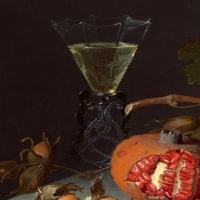Over the course of the 17th century, the Dutch Republic’s booming economy ensured that wines imported from France, the Iberian Peninsula, the Mediterranean, and the southern Rhine valley came within the financial reach of an increasingly large segment of the population
Dutch Burghers and Their Wine: Nary a Sour Grape
Historically, beer was a dietary staple throughout northern Europe, as the brewed liquid was far safer to drink than plain water

Fig. 4 - Jacob van Walscapelle, Still Life with Fruit (detail), 1675, oil on panel, National Gallery of Art, Washington, Juliet and Lee Folger/The Folger Fund
All alcohol was subject to consumption tax, and municipalities employed wijn roeiers (sworn wine gaugers) for proper assessments. Applying sophisticated mathematical skills, these specialists could calculate a barrel’s exact content after measuring the liquid’s level with a marked rod stuck through the bunghole. Tax was paid on quantity and quality, and the resulting impost voucher became akin to a barrel’s passport, by which it could be cellared, sold, and transported. Anthonie van Leeuwenhoek, the celebrated scientist who was likely immortalized by Johannes Vermeer in both The Astronomer (Musée du Louvre, Paris) and The Geographer
The various taxes placed on alcohol made smuggling an attractive option. Tax evasion, however, also created unfair competition by allowing a tavern keeper or wine merchant to sell his stock at below-market prices. One account mentions two wine buyers going undercover to assess the black market. In an unlicensed house “filled with so many people that it was difficult to find a place to sit,” they drank new wine at the bargain price of 25 cents per pitcher. In another tavern, the publican admitted that he “sold much more smuggled wines than before,” but that he was loath to have too many people flock to his establishment because it might draw the attention of the law.
Only failed attempts to avoid the hated excise tax on alcohol turn up in public records. For example, in 1628 municipal impost officials arrested a woman leaving a wine buyer’s house with a pitcher of wine for which she had not paid tax, despite a boisterous crowd coming to her aid. In a second case, a revenuer stopped a woman carrying a bottle of wine that did not have its impost voucher
A moralistic publication of 1641 warns Dutch youths against debauchery in taverns. Upper-class students, enrolled in Rotterdam’s Latin school, spent much of their time drinking and playing cards in taverns. A group of four revelers ran up a huge tab of 24 guilders in the tavern The Prince’s Ship, and after gambling away all their money, they first pawned their clothes but later resorted to theft to pay for their wild ways. They were expelled from school.
Under normal circumstances, enjoying a glass of wine did not create a situation that led to a police report, so most evidence we have of alcohol consumption comes from import and taxation statistics, plays, and genre paintings and “merry company” scenes. So how much wine did the Dutch actually consume? If we believe Sir William Temple, England’s ambassador, the Dutch population was wretchedly frugal, except in one thing: “Their great Forreign Consumption, is French-Wine and Brandy; But that may be allow’d them, as the only Reward they enjoy of all their pains, and as that alone which makes them rich and happy in their voluntary Poverty, who would otherwise seem poor and wretched in their real Wealth.”
A poem of 1623 emphasized that “wine chases away sadness,” but this mood enhancer only applied to the happy few who drank wine on a regular basis. And it was this happy echelon of Dutch society, with a glass of wine at hand, that the masters of genre painting depicted so expressively
Henriette Rahusen
Thu Oct 19 00:00:00 EDT 2017








